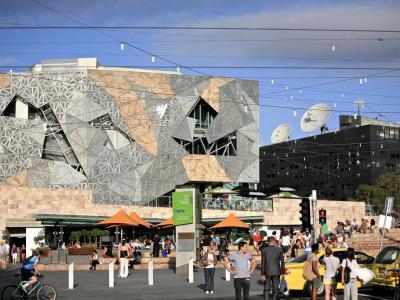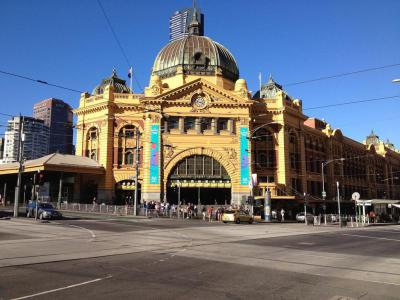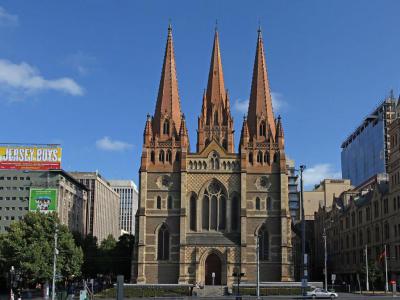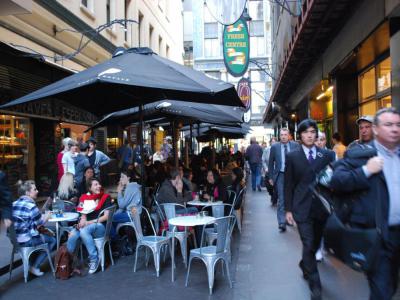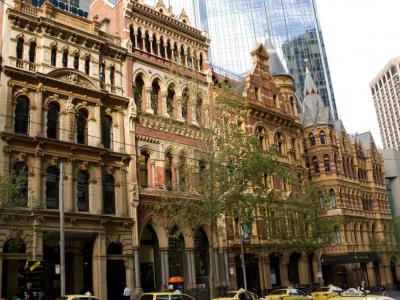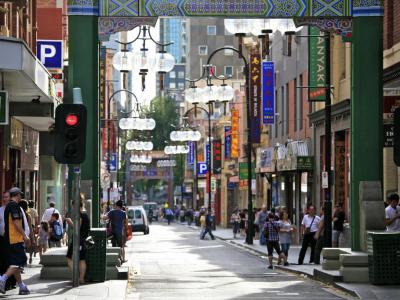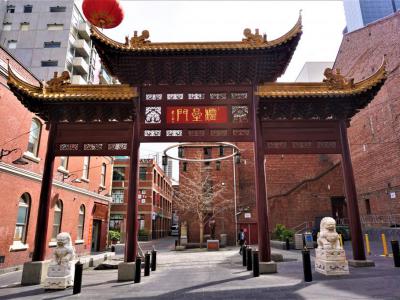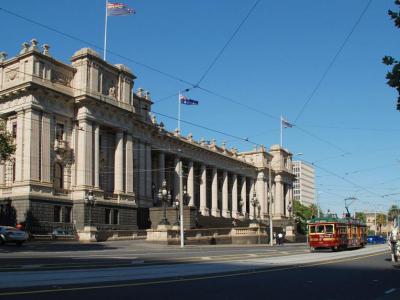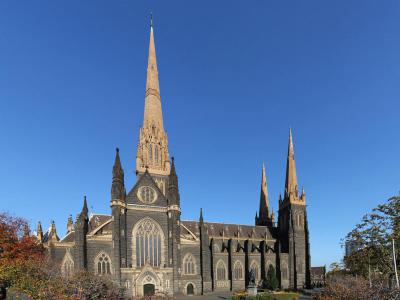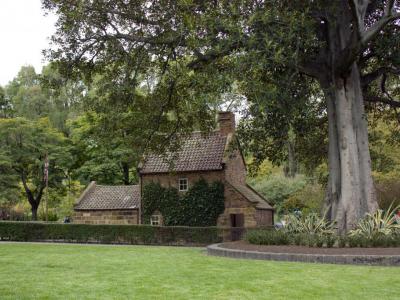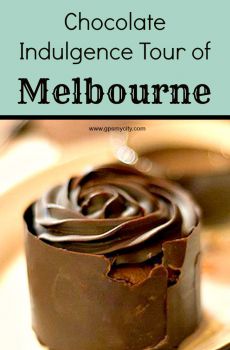Melbourne Introduction Walking Tour (Self Guided), Melbourne
Melbourne is the capital and largest city in the Australian state of Victoria. The metro area consists of 31 different towns spread around the bay of Port Philip. Indigenous Australians have lived here for more than 40,000 years. European settlement began in the 1830s when settlers arrived from Van Diemen's Land (Tasmania). The settlement, incorporated in 1837, was named for the British Prime Minister, William Lamb, 2nd Viscount Melbourne.
The city went through several booms and maintains a steady influx of newcomers to this day. The first surge occurred in the 1850s when gold was discovered in Victoria. During this boom, Chinese immigrants began forming Chinatown, a popular destination on Little Bourke Street.
From 1901 to 1927, Melbourne served as the national capital while Canberra was built. You can tour the Parliament House, which is where the national government sat during those early years.
Present-day Melbourne is an international financial center and contains many of the nation's best-known landmarks. It's a UNESCO City of Literature due to its vibrant street art, music, and theater scene. The main part of town, known as the Central Business District (CBD), houses many attractions, including Flinders Street Station railway hub, Federation Square, and the Block and Royal Arcades. The most extensive tram system in the world operates in Melbourne, so getting around is always easy.
Melbourne stands out as a unique walking destination. Winding between buildings and through their ground floors, pedestrians can find hidden restaurants, shops, and street art. These might be considered dark and seedy alleys in any other town, but in Melbourne, these "laneways" and "arcades" are the tour highlights. Don't miss the Block Arcade and Degraves Street. If you'd like to check out even more of these hidden gems, take our Laneways and Arcades Walking Tour.
Melbourne is an energetic city with a ton of things to see and do. For a peek at its top rated attractions, take this self-guided walking tour of Melbourne.
The city went through several booms and maintains a steady influx of newcomers to this day. The first surge occurred in the 1850s when gold was discovered in Victoria. During this boom, Chinese immigrants began forming Chinatown, a popular destination on Little Bourke Street.
From 1901 to 1927, Melbourne served as the national capital while Canberra was built. You can tour the Parliament House, which is where the national government sat during those early years.
Present-day Melbourne is an international financial center and contains many of the nation's best-known landmarks. It's a UNESCO City of Literature due to its vibrant street art, music, and theater scene. The main part of town, known as the Central Business District (CBD), houses many attractions, including Flinders Street Station railway hub, Federation Square, and the Block and Royal Arcades. The most extensive tram system in the world operates in Melbourne, so getting around is always easy.
Melbourne stands out as a unique walking destination. Winding between buildings and through their ground floors, pedestrians can find hidden restaurants, shops, and street art. These might be considered dark and seedy alleys in any other town, but in Melbourne, these "laneways" and "arcades" are the tour highlights. Don't miss the Block Arcade and Degraves Street. If you'd like to check out even more of these hidden gems, take our Laneways and Arcades Walking Tour.
Melbourne is an energetic city with a ton of things to see and do. For a peek at its top rated attractions, take this self-guided walking tour of Melbourne.
How it works: Download the app "GPSmyCity: Walks in 1K+ Cities" from Apple App Store or Google Play Store to your mobile phone or tablet. The app turns your mobile device into a personal tour guide and its built-in GPS navigation functions guide you from one tour stop to next. The app works offline, so no data plan is needed when traveling abroad.
Melbourne Introduction Walking Tour Map
Guide Name: Melbourne Introduction Walking Tour
Guide Location: Australia » Melbourne (See other walking tours in Melbourne)
Guide Type: Self-guided Walking Tour (Sightseeing)
# of Attractions: 11
Tour Duration: 2 Hour(s)
Travel Distance: 3.5 Km or 2.2 Miles
Author: vickyc
Sight(s) Featured in This Guide:
Guide Location: Australia » Melbourne (See other walking tours in Melbourne)
Guide Type: Self-guided Walking Tour (Sightseeing)
# of Attractions: 11
Tour Duration: 2 Hour(s)
Travel Distance: 3.5 Km or 2.2 Miles
Author: vickyc
Sight(s) Featured in This Guide:
- Federation Square
- Flinders Street Station
- St. Paul's Cathedral
- Degraves Street
- Block Arcade
- Collins Street
- Little Bourke Street
- Chinese Museum
- Parliament House of Victoria
- St. Patrick's Cathedral
- Fitzroy Gardens and Captain Cook's Cottage
1) Federation Square
Fed Square — yes, everyone calls it that — finally opened in 2001, after decades of Melbourne wondering why a major city had managed to function without an actual public square since the 1800s. The solution was delightfully bold: just build it right on top of the old railway yards. Prime location, close to the river, no extra land needed — problem solved.
Since then, the place has turned into Melbourne’s cultural magnet. With more than eight million visitors and around two thousand events each year, the square rarely has a quiet moment. One day it’s a food festival, the next it’s a film screening, and by the weekend you might stumble into a live performance you didn’t know was on.
Two anchors define the square’s artistic energy: the Australian Centre for the Moving Image, which is the country’s home for all things film and digital culture, and the Ian Potter Centre, the National Gallery of Victoria’s base for Australian art, both old and new. Together, they do a fine job of filling the square with ideas, stories, and the occasional burst of creative chaos.
And then there’s the architecture — a patchwork of sharp angles, cranked lines, and deconstructivist drama. The buildings look like they’ve been assembled from giant geometric puzzle pieces, with glass corridors splitting them apart like modern takes on Melbourne’s historic laneways. Those tall “shards” hiding staircases and lifts are all part of the fun. And if you notice pinwheel-patterned tiles under your feet, yes, they’re meant to catch your eye.
Down toward the Yarra, the square softens into leafy paths leading to Federation Wharf, where cafés and a small marina share a calmer slice of the riverfront.
Indeed, sitting right in the middle of Melbourne’s heartbeat, Fed Square is a safe bet you'll catch something happening here all the time. Just pick up some takeaway, find a seat, and let the city’s atmosphere do the rest. The events calendar on Fed Square’s website will help you keep up — if you can...
Since then, the place has turned into Melbourne’s cultural magnet. With more than eight million visitors and around two thousand events each year, the square rarely has a quiet moment. One day it’s a food festival, the next it’s a film screening, and by the weekend you might stumble into a live performance you didn’t know was on.
Two anchors define the square’s artistic energy: the Australian Centre for the Moving Image, which is the country’s home for all things film and digital culture, and the Ian Potter Centre, the National Gallery of Victoria’s base for Australian art, both old and new. Together, they do a fine job of filling the square with ideas, stories, and the occasional burst of creative chaos.
And then there’s the architecture — a patchwork of sharp angles, cranked lines, and deconstructivist drama. The buildings look like they’ve been assembled from giant geometric puzzle pieces, with glass corridors splitting them apart like modern takes on Melbourne’s historic laneways. Those tall “shards” hiding staircases and lifts are all part of the fun. And if you notice pinwheel-patterned tiles under your feet, yes, they’re meant to catch your eye.
Down toward the Yarra, the square softens into leafy paths leading to Federation Wharf, where cafés and a small marina share a calmer slice of the riverfront.
Indeed, sitting right in the middle of Melbourne’s heartbeat, Fed Square is a safe bet you'll catch something happening here all the time. Just pick up some takeaway, find a seat, and let the city’s atmosphere do the rest. The events calendar on Fed Square’s website will help you keep up — if you can...
2) Flinders Street Station
If you’re standing at the corner of Flinders and Swanston Streets and wondering why everyone else is looking up—congrats, you’ve found Flinders Street Station! It opened in 1854 as the terminus of Australia’s very first railway, back when “catching a train” meant something closer to “braving an experiment.” Today, it’s still one of Melbourne’s busiest transport hubs, funneling commuters across the suburbs and deep into the city’s daily rhythm.
The building you see now arrived later, finished in 1909. It’s an Edwardian creation that doesn’t believe in subtlety—domes, arches, towers, and enough ornamentation to fuel a century of urban legends. The curious fact associated with this building is that its design was mistakenly swapped with plans for Victoria Terminus in Bombay. No proof, however, but the rumour is almost as iconic as the station itself. Heritage-listed and instantly recognisable, it remains one of Melbourne’s most photographed faces.
And then there are the clocks. If someone in Melbourne tells you to meet them “under the clocks,” they’re not being poetic—that’s the row of indicator clocks above the main entrance. Another classic rendezvous point here is “On the steps.” Basically, this station doubles as both a transit hub and the city’s unofficial meeting app...
Its location doesn’t hurt either. Step outside and you’re right beside Federation Square, the Yarra River, and the maze of laneways, cafés, and arcades that make up the Central Business District. A truly perfect launchpad for whatever you’re doing next...
Indeed, whenever you're in Melbourne, even if you’re not catching a train, this building is always a delight to look at. The food inside is tempting, and—bonus—the station turns into a glowing postcard at night. So, make sure to have a camera handy; it likes the attention...
The building you see now arrived later, finished in 1909. It’s an Edwardian creation that doesn’t believe in subtlety—domes, arches, towers, and enough ornamentation to fuel a century of urban legends. The curious fact associated with this building is that its design was mistakenly swapped with plans for Victoria Terminus in Bombay. No proof, however, but the rumour is almost as iconic as the station itself. Heritage-listed and instantly recognisable, it remains one of Melbourne’s most photographed faces.
And then there are the clocks. If someone in Melbourne tells you to meet them “under the clocks,” they’re not being poetic—that’s the row of indicator clocks above the main entrance. Another classic rendezvous point here is “On the steps.” Basically, this station doubles as both a transit hub and the city’s unofficial meeting app...
Its location doesn’t hurt either. Step outside and you’re right beside Federation Square, the Yarra River, and the maze of laneways, cafés, and arcades that make up the Central Business District. A truly perfect launchpad for whatever you’re doing next...
Indeed, whenever you're in Melbourne, even if you’re not catching a train, this building is always a delight to look at. The food inside is tempting, and—bonus—the station turns into a glowing postcard at night. So, make sure to have a camera handy; it likes the attention...
3) St. Paul's Cathedral
Sitting just across from the hustle of Flinders Street Station, Saint Paul’s Cathedral is a calm reminder to everyone that Melbourne’s skyline had a spiritual side long before espresso bars and laneway murals took over. This spot is more meaningful than it looks: it was here that the very first Christian service in the fledgling settlement was held in 1835, after which the site briefly served as a corn market. Indeed, only in Melbourne could a place go from a prayer to a produce before becoming a cathedral...
The building itself is the work of English architect William Butterfield, who designed it in the Gothic Revival style—characterized by soaring arches with a slightly rebellious streak. The foundation stone went in during 1880, the cathedral was consecrated in 1891, and the spires joined the complex in the 1920s, giving Saint Paul’s the silhouette that now anchors the Central Business District.
Inside, the soundscape is just as impressive. The T.C. Lewis organ, shipped from England, remains one of the finest surviving creations of the celebrated 19th-century organ maker. And if you happen to be nearby on a Wednesday or Friday evening—or on a Sunday morning—you’ll hear the bells, too. Cast in 1889 at London’s Whitechapel Bell Foundry, they offer something rare: true 13-bell change ringing, a tradition that usually stays on English soil.
Saint Paul’s keeps its doors open most of the week, so step inside whenever the mood strikes. Whether you’re drawn by the architecture, the music, or simply the peaceful break from the city’s pace, the cathedral delivers a moment of calm in the middle of Melbourne’s constant motion...
The building itself is the work of English architect William Butterfield, who designed it in the Gothic Revival style—characterized by soaring arches with a slightly rebellious streak. The foundation stone went in during 1880, the cathedral was consecrated in 1891, and the spires joined the complex in the 1920s, giving Saint Paul’s the silhouette that now anchors the Central Business District.
Inside, the soundscape is just as impressive. The T.C. Lewis organ, shipped from England, remains one of the finest surviving creations of the celebrated 19th-century organ maker. And if you happen to be nearby on a Wednesday or Friday evening—or on a Sunday morning—you’ll hear the bells, too. Cast in 1889 at London’s Whitechapel Bell Foundry, they offer something rare: true 13-bell change ringing, a tradition that usually stays on English soil.
Saint Paul’s keeps its doors open most of the week, so step inside whenever the mood strikes. Whether you’re drawn by the architecture, the music, or simply the peaceful break from the city’s pace, the cathedral delivers a moment of calm in the middle of Melbourne’s constant motion...
4) Degraves Street
Slip off Flinders Street and onto Degraves, and suddenly Melbourne feels like it’s trying on a little Parisian flair. This narrow cobbled lane is strictly for pedestrians—no cars, just the steady hum of coffee machines, clinking glasses, and people debating which café has the best flat white. If you’re hunting for a sunny table to enjoy lunch outdoors, Degraves practically waves you over. Just don’t mix it up with Centre Place, its equally charming but often confused neighbour.
Look up, and you’ll spot the taller buildings that have been reborn as loft-style apartments, adding residents—and energy—to the laneway below. Down at street level, the soundtrack is classic Melbourne: buskers setting the mood, street art bursting from every corner, and the occasional splash of graffiti reminding you that creativity here comes in all forms.
The name “Degraves” goes back to Charles and William Degraves, merchants from Hobart who arrived here with flour-mill ambitions in 1849. William later dabbled in local politics, proving that even back then, Degraves attracted people who liked to stay busy...
Today, the lane acts as a lively connector between Flinders Street Station and the shopping streets to the north. If you need a shortcut underground, Campbell Arcade—better known to locals as the Degraves Underpass—whisks you beneath the traffic. Keep an eye out for the Platform Artists Group, who regularly turn the space into an ever-changing mini-gallery.
Step in, slow down, and enjoy the show—Degraves is Melbourne’s laneway culture at its most irresistible.
Look up, and you’ll spot the taller buildings that have been reborn as loft-style apartments, adding residents—and energy—to the laneway below. Down at street level, the soundtrack is classic Melbourne: buskers setting the mood, street art bursting from every corner, and the occasional splash of graffiti reminding you that creativity here comes in all forms.
The name “Degraves” goes back to Charles and William Degraves, merchants from Hobart who arrived here with flour-mill ambitions in 1849. William later dabbled in local politics, proving that even back then, Degraves attracted people who liked to stay busy...
Today, the lane acts as a lively connector between Flinders Street Station and the shopping streets to the north. If you need a shortcut underground, Campbell Arcade—better known to locals as the Degraves Underpass—whisks you beneath the traffic. Keep an eye out for the Platform Artists Group, who regularly turn the space into an ever-changing mini-gallery.
Step in, slow down, and enjoy the show—Degraves is Melbourne’s laneway culture at its most irresistible.
5) Block Arcade (must see)
If Melbourne had a catwalk, the Block Arcade would be strutting right down the middle of it in full glamour mode. Opened in 1892, this lavish stretch of French Renaissance beauty is all towering arches, ornate cornices, and decorative tiles—basically the architectural equivalent of overdressing for every occasion, and loving it. Inside, boutiques and tea rooms line the walkways, echoing the days when this was the most fashionable shopping runway in town just off Collins Street.
Shaped like an elegant L and crowned at the bend with a domed rotunda that refuses to be ignored, the arcade links Elizabeth Street to Collins Street. And if you walk in from the Collins side, you’ll find yourself facing its slightly older sibling, the Royal Arcade, as if the two have been politely competing for attention since the Victorian era...
The name “Block Arcade” comes from the 19th-century pastime of “doing the block,” when Melbourne’s elite would dress to impress and glide along Collins Street and its arcades. This was the place to see—and be seen—long before Instagram tried to claim the job...
Nowadays, people keep stopping by because a walk through the Block Arcade feels like stepping straight into Victorian Melbourne, minus the horse-drawn traffic... Those soaring six-storey façades and meticulously restored interior are textbook Mannerist drama, and the whole place is proudly listed on the Victorian Heritage Register—because, frankly, how could it possibly not be?
And now for a tip worthy of your inner aristocrat: the Hopetoun Tea Rooms. First opened in 1894 and redecorated in 1976 in full Victorian splendour, it still delivers the kind of tea service that expects you to sit up straight and behave elegantly—well, at least until dessert arrives...
Since you're already here, glance across the street to the Royal Arcade for another dose of grandeur. Or take a quick detour into Block Court next door—its Art Deco interior no longer houses an arcade of shops, but it certainly still knows how to make an entrance.
Shaped like an elegant L and crowned at the bend with a domed rotunda that refuses to be ignored, the arcade links Elizabeth Street to Collins Street. And if you walk in from the Collins side, you’ll find yourself facing its slightly older sibling, the Royal Arcade, as if the two have been politely competing for attention since the Victorian era...
The name “Block Arcade” comes from the 19th-century pastime of “doing the block,” when Melbourne’s elite would dress to impress and glide along Collins Street and its arcades. This was the place to see—and be seen—long before Instagram tried to claim the job...
Nowadays, people keep stopping by because a walk through the Block Arcade feels like stepping straight into Victorian Melbourne, minus the horse-drawn traffic... Those soaring six-storey façades and meticulously restored interior are textbook Mannerist drama, and the whole place is proudly listed on the Victorian Heritage Register—because, frankly, how could it possibly not be?
And now for a tip worthy of your inner aristocrat: the Hopetoun Tea Rooms. First opened in 1894 and redecorated in 1976 in full Victorian splendour, it still delivers the kind of tea service that expects you to sit up straight and behave elegantly—well, at least until dessert arrives...
Since you're already here, glance across the street to the Royal Arcade for another dose of grandeur. Or take a quick detour into Block Court next door—its Art Deco interior no longer houses an arcade of shops, but it certainly still knows how to make an entrance.
6) Collins Street
Collins Street is one of those Melbourne originals—the kind that’s been here since the city first got its grid in 1837. Surveyor Robert Hoddle drew the lines, measured the angles, and declared that this street would be exactly one mile long and one chain (that is, 99 feet) wide. And Melbourne, obedient as ever, still follows his blueprint. The name itself comes from Lieutenant-Governor David Collins, who led the founding of Sorrento in 1803—which was the first British settlement in Australia outside of Sydney (back when Tasmania was still Van Diemen’s Land and Australia’s map was mostly wishful thinking)...
Head to the east end, and you’ll hear locals call it the “Paris End”—and honestly, they have a point. With its leafy trees, heritage facades, cafés spilling onto the sidewalk, and boutiques that look like they charge by the eyebrow raise, it gives off an unmistakably French mood. Walk west toward Queen Street, and the atmosphere shifts. This has been Melbourne’s financial district since the 1800s—less croissants, more contracts. The Block Arcade sits at the retail heart of it all, linking Swanston and Elizabeth Streets with old-world charm and enough mosaic flooring to make a Roman jealous.
Over the years, Collins Street has had its share of upgrades, no doubt. Elm trees arrived in 1875, trams clattered in by 1885—originally cable-drawn until electricity took over in 1930. Sadly, not everything survived progress: many boom-time buildings were swept away during the 1950s and '60s redevelopment wave.
But a few architectural gems still hold their ground. The Collins Street Baptist Church, Scot’s Presbyterian Church, and Saint Michael’s Uniting Church keep the Victorian spirit alive, while Alston’s Corner (designed in 1914) shows off Edwardian flair. And at the business end, the dramatic Gothic towers—nicknamed the “Cathedrals of Commerce”—remind you that even accountants can have a sense of style...
Head to the east end, and you’ll hear locals call it the “Paris End”—and honestly, they have a point. With its leafy trees, heritage facades, cafés spilling onto the sidewalk, and boutiques that look like they charge by the eyebrow raise, it gives off an unmistakably French mood. Walk west toward Queen Street, and the atmosphere shifts. This has been Melbourne’s financial district since the 1800s—less croissants, more contracts. The Block Arcade sits at the retail heart of it all, linking Swanston and Elizabeth Streets with old-world charm and enough mosaic flooring to make a Roman jealous.
Over the years, Collins Street has had its share of upgrades, no doubt. Elm trees arrived in 1875, trams clattered in by 1885—originally cable-drawn until electricity took over in 1930. Sadly, not everything survived progress: many boom-time buildings were swept away during the 1950s and '60s redevelopment wave.
But a few architectural gems still hold their ground. The Collins Street Baptist Church, Scot’s Presbyterian Church, and Saint Michael’s Uniting Church keep the Victorian spirit alive, while Alston’s Corner (designed in 1914) shows off Edwardian flair. And at the business end, the dramatic Gothic towers—nicknamed the “Cathedrals of Commerce”—remind you that even accountants can have a sense of style...
7) Little Bourke Street
Little Bourke Street may sound modest, but don’t be fooled by its name—this is one of Melbourne’s original east-to-west thoroughfares and the heartbeat of the city’s Chinatown. Heading toward its eastern end, the street suddenly turns into a maze of neon signs, narrow laneways, and arcades that have been buzzing with life since the 1850s, when Chinese immigrants first made this neighbourhood their Australian home.
Today, Chinatown still delivers the classics—dumplings, herbal shops, and sizzling woks—but the menu has expanded far beyond China’s borders. Within a few steps, you can wander from Thai curries to Japanese noodles, Malaysian sweets, Vietnamese grills, Indian spices, and Korean barbecue. Add in annual celebrations like Lunar New Year, and you’ll understand why the area feels like a festival even on a slow afternoon. And if the aromas don’t catch your attention, the architecture will: Victorian-era buildings dressed up with colourful Chinese motifs create a quirky fusion that’s unmistakably Melbourne.
For anyone curious about how Chinese communities shaped the city, pop into the Museum of Chinese Australian History on Cohen Place. It’s compact, engaging, and full of stories that bring the neighbourhood to life. Nearby, the MidCity Arcade offers its own sheltered world of fusion eateries, quirky shops, and splashes of street art—perfect for a wander when the weather can’t make up its mind.
And before you leave, look for the Facing Heaven Archway on Cohen Street. With imperial lions guarding its base and a design inspired by a Ming-dynasty gateway, it’s the kind of landmark that practically insists on being photographed.
Melbourne’s Chinatown may sit on Little Bourke Street—but there’s nothing little about its personality.
Today, Chinatown still delivers the classics—dumplings, herbal shops, and sizzling woks—but the menu has expanded far beyond China’s borders. Within a few steps, you can wander from Thai curries to Japanese noodles, Malaysian sweets, Vietnamese grills, Indian spices, and Korean barbecue. Add in annual celebrations like Lunar New Year, and you’ll understand why the area feels like a festival even on a slow afternoon. And if the aromas don’t catch your attention, the architecture will: Victorian-era buildings dressed up with colourful Chinese motifs create a quirky fusion that’s unmistakably Melbourne.
For anyone curious about how Chinese communities shaped the city, pop into the Museum of Chinese Australian History on Cohen Place. It’s compact, engaging, and full of stories that bring the neighbourhood to life. Nearby, the MidCity Arcade offers its own sheltered world of fusion eateries, quirky shops, and splashes of street art—perfect for a wander when the weather can’t make up its mind.
And before you leave, look for the Facing Heaven Archway on Cohen Street. With imperial lions guarding its base and a design inspired by a Ming-dynasty gateway, it’s the kind of landmark that practically insists on being photographed.
Melbourne’s Chinatown may sit on Little Bourke Street—but there’s nothing little about its personality.
8) Chinese Museum (must see)
If you're in Melbourne’s Chinatown and feeling like you’ve stepped into a story with a long memory, you’re not wrong. Tucked right into the Central Business District is the Chinese Museum, a place that doesn’t merely display history but practically invites you to time-travel. Indeed, here Chinatown hums the loudest. In a way, it's Melbourne’s backstage pass to understanding how Chinese communities shaped Victoria, starting way back in the gold-rush days of the 1850s.
Back then, thousands of migrants arrived from southern China, many from poor villages around Canton. Some chased gold, others planted market gardens or opened shops, and nearly all sent money back home while trying to build a new life here. The museum pieces their journeys together using artefacts, photos, documents, and the occasional object that makes you wonder how it survived the 19th century at all.
Inside, you’ll find exhibitions with personality. “Discovering Melbourne’s Chinatown” tells the origin story of the neighbourhood around you. “Finding Gold” lets you experience the gold rush through Chinese eyes (minus the blisters and backache). “Melbourne’s Dragons” unveils a century’s worth of parade dragons, the kind that make every festival feel like a blockbuster. “Bridge of Memories” maps out how more than half a million Chinese immigrants arrived over the past fifty years, while “Chinese Australians” takes you right back to convict days, reminding you that the community’s roots run deeper than most think.
The museum is open daily from 10 a.m. to 4 p.m. and doubles as the Chinatown Visitors Centre. Some exhibits are free; others ask for a small fee — a fair trade for several floors of time-hopping...
Tip:
There aren’t scheduled tours, but you won’t miss them. Your ticket comes with a handy guide for a self-paced wander, so no microphone-wielding guide will be necessary...
Back then, thousands of migrants arrived from southern China, many from poor villages around Canton. Some chased gold, others planted market gardens or opened shops, and nearly all sent money back home while trying to build a new life here. The museum pieces their journeys together using artefacts, photos, documents, and the occasional object that makes you wonder how it survived the 19th century at all.
Inside, you’ll find exhibitions with personality. “Discovering Melbourne’s Chinatown” tells the origin story of the neighbourhood around you. “Finding Gold” lets you experience the gold rush through Chinese eyes (minus the blisters and backache). “Melbourne’s Dragons” unveils a century’s worth of parade dragons, the kind that make every festival feel like a blockbuster. “Bridge of Memories” maps out how more than half a million Chinese immigrants arrived over the past fifty years, while “Chinese Australians” takes you right back to convict days, reminding you that the community’s roots run deeper than most think.
The museum is open daily from 10 a.m. to 4 p.m. and doubles as the Chinatown Visitors Centre. Some exhibits are free; others ask for a small fee — a fair trade for several floors of time-hopping...
Tip:
There aren’t scheduled tours, but you won’t miss them. Your ticket comes with a handy guide for a self-paced wander, so no microphone-wielding guide will be necessary...
9) Parliament House of Victoria
If you're wandering up Bourke Street and wonder why a massive Greek temple seems to be moonlighting as a government office, that would be Parliament House—Victoria’s political headquarters and one of Melbourne’s proudest 19th-century flexes. This is where the state’s two chambers meet: 88 seats downstairs in the Legislative Assembly and 40 upstairs in the Legislative Council. In essence, it is the place where democracy happens… in carefully structured debates and occasionally dramatic headlines.
It all started back in 1851, when Victoria broke away from New South Wales and suddenly needed a building that would declare, “Yes, we are absolutely capable of running our own affairs.” Architects Charles Pasley and Peter Kerr took that mission very seriously, borrowing heavily from ancient Greece and Rome (which is what you do when setting up a new democracy), then positioning their creation on one of the most commanding sites in the young city.
Construction kicked off in 1856, although “construction” may be too generous a word for a project that unfolded in slow, theatrical acts over 70 years. The two parliamentary chambers were finished first, so lawmakers could start legislating, while the rest of the building politely caught up. Additions like the library, Queen’s Hall, and the eastern wing appeared over time. Although the original plans also envisioned an elaborate dome above the building’s central vestibule, cost concerns meant this feature never materialized. Still, the colonnade and Grand Vestibule delivered enough grandeur to make the dome’s absence feel almost intentional.
Then came 1901, when Australia became a federation, and Melbourne was tapped to host the brand-new Federal Parliament. For 26 years, national politics unfolded inside this very building while Victoria’s Parliament temporarily moved out (proving that Parliament House could multitask long before it became a résumé requirement).
Today, after rounds of restoration and modern upgrades, the building continues its original job: housing Victoria’s Parliament, while looking impressive enough to remind everyone where the big decisions are made...
It all started back in 1851, when Victoria broke away from New South Wales and suddenly needed a building that would declare, “Yes, we are absolutely capable of running our own affairs.” Architects Charles Pasley and Peter Kerr took that mission very seriously, borrowing heavily from ancient Greece and Rome (which is what you do when setting up a new democracy), then positioning their creation on one of the most commanding sites in the young city.
Construction kicked off in 1856, although “construction” may be too generous a word for a project that unfolded in slow, theatrical acts over 70 years. The two parliamentary chambers were finished first, so lawmakers could start legislating, while the rest of the building politely caught up. Additions like the library, Queen’s Hall, and the eastern wing appeared over time. Although the original plans also envisioned an elaborate dome above the building’s central vestibule, cost concerns meant this feature never materialized. Still, the colonnade and Grand Vestibule delivered enough grandeur to make the dome’s absence feel almost intentional.
Then came 1901, when Australia became a federation, and Melbourne was tapped to host the brand-new Federal Parliament. For 26 years, national politics unfolded inside this very building while Victoria’s Parliament temporarily moved out (proving that Parliament House could multitask long before it became a résumé requirement).
Today, after rounds of restoration and modern upgrades, the building continues its original job: housing Victoria’s Parliament, while looking impressive enough to remind everyone where the big decisions are made...
10) St. Patrick's Cathedral (must see)
Saint Patrick’s Cathedral—rising from Eastern Hill—practically announces itself as one of Australia’s most commanding religious landmarks. Indeed, this Gothic Revival giant has been stopping people in their tracks since the 19th century.
Its story started when Melbourne’s Catholic population ballooned during the gold rush—because nothing attracts crowds like the promise of fortune... In 1848, Bishop James Goold arrived in Melbourne with big ambitions and a keen eye for real estate. Having quickly realised he needed more than just a modest chapel, Goold secured this hilltop site in 1851.
Architect William Wardell was brought in to sketch a Gothic Revival masterpiece worthy of a rising city. The plans were bold, soaring, and dramatic… His blueprint channelled medieval England with a Melbourne twist, all built in brooding bluestone and sandstone for maximum gravitas.
Although ready early on, the project didn't progress very swiftly. Amid the gold rush, with half the colony's workforce off chasing fortune, the actual construction didn’t get moving until 1858. Over the following decades, sections appeared piece by piece: nave, choir, transepts—like a very long, very serious architectural jigsaw...
Economic troubles in the 1890s slowed everything further, but perseverance won out, and the cathedral was finally consecrated in 1897. Still, the iconic trio of spires was fashionably late and arrived only in 1939. Once in place, they crowned the cathedral as the tallest church site in Australia (a title it still holds), soaring to 103 metres, as if trying to tap the heavens on the shoulder...
Inside, the grandeur continues with stained glass that glows like jewellery, intricate timber carvings, and an elaborate high-altar reredos—all nods to the Irish heritage of Melbourne’s early Catholic community, who saw the cathedral as both a spiritual home and a cultural anchor. And while the décor is historic, the building itself hasn’t been left to age quietly; careful conservation has kept it looking as commanding as ever.
Today, Saint Patrick’s welcomes visitors from 9 a.m. to 5 p.m., and you’ll often find friendly volunteers ready to share stories, point out hidden details, or explain why Wardell loved Gothic Revival as much as he did.
Tip:
Check for services before stepping inside. When the cathedral isn’t hosting worship, you’re free to wander, linger, admire the stained glass, and capture your perfect photo of those soaring spires.
Its story started when Melbourne’s Catholic population ballooned during the gold rush—because nothing attracts crowds like the promise of fortune... In 1848, Bishop James Goold arrived in Melbourne with big ambitions and a keen eye for real estate. Having quickly realised he needed more than just a modest chapel, Goold secured this hilltop site in 1851.
Architect William Wardell was brought in to sketch a Gothic Revival masterpiece worthy of a rising city. The plans were bold, soaring, and dramatic… His blueprint channelled medieval England with a Melbourne twist, all built in brooding bluestone and sandstone for maximum gravitas.
Although ready early on, the project didn't progress very swiftly. Amid the gold rush, with half the colony's workforce off chasing fortune, the actual construction didn’t get moving until 1858. Over the following decades, sections appeared piece by piece: nave, choir, transepts—like a very long, very serious architectural jigsaw...
Economic troubles in the 1890s slowed everything further, but perseverance won out, and the cathedral was finally consecrated in 1897. Still, the iconic trio of spires was fashionably late and arrived only in 1939. Once in place, they crowned the cathedral as the tallest church site in Australia (a title it still holds), soaring to 103 metres, as if trying to tap the heavens on the shoulder...
Inside, the grandeur continues with stained glass that glows like jewellery, intricate timber carvings, and an elaborate high-altar reredos—all nods to the Irish heritage of Melbourne’s early Catholic community, who saw the cathedral as both a spiritual home and a cultural anchor. And while the décor is historic, the building itself hasn’t been left to age quietly; careful conservation has kept it looking as commanding as ever.
Today, Saint Patrick’s welcomes visitors from 9 a.m. to 5 p.m., and you’ll often find friendly volunteers ready to share stories, point out hidden details, or explain why Wardell loved Gothic Revival as much as he did.
Tip:
Check for services before stepping inside. When the cathedral isn’t hosting worship, you’re free to wander, linger, admire the stained glass, and capture your perfect photo of those soaring spires.
11) Fitzroy Gardens and Captain Cook's Cottage (must see)
On the southeastern edge of Melbourne’s Central Business District, the city suddenly exhales—with 64 acres of Fitzroy Gardens opening up like a green antidote to downtown hustle. Laid out back in 1848 and named after the then Governor of New South Wales, Sir Charles Augustus FitzRoy, these Victorian-era gardens come packed with an ornamental lake, a glass conservatory, a miniature Tudor village, and one very well-travelled cottage.
That cottage, Cooks’ Cottage, began life in 1755 in Great Ayton, North Yorkshire, England, where Captain James Cook’s parents built it long before anyone imagined it would one day cross the globe. In 1933, the cottage was taken apart brick by brick, packed into 253 cases and 40 barrels, and shipped to Melbourne aboard the cargo vessel Port Dunedin. Even the ivy tagging along today comes from cuttings of the original plant—proof that homesickness isn’t just for people... Though Cook may or may not have ever lived in this cottage himself, it now holds the title of Australia’s oldest standing building, which is quite a twist for something that started life on the other side of the world.
Restored in 1978, the house now sits inside a cottage garden, with antiques and costumed guides offering a glimpse into 18th-century domestic life—no electricity, no smartphones, and other technical delights of today...
Indeed, Melbourne likes to call itself Australia’s garden city, and Fitzroy Gardens is its strongest argument. Long, tree-lined paths, fountains, sculptures, and the Spanish mission-style conservatory (housing impressive floral displays) create a calm inner-city retreat where your biggest decision is whether to linger in the sun or keep exploring.
For a quick break, the KereKere Café by the visitor centre has you covered. Most visitors stay under an hour, but with sunshine, lawns, and picnic spots everywhere you look, stretching that into an afternoon feels entirely justified.
That cottage, Cooks’ Cottage, began life in 1755 in Great Ayton, North Yorkshire, England, where Captain James Cook’s parents built it long before anyone imagined it would one day cross the globe. In 1933, the cottage was taken apart brick by brick, packed into 253 cases and 40 barrels, and shipped to Melbourne aboard the cargo vessel Port Dunedin. Even the ivy tagging along today comes from cuttings of the original plant—proof that homesickness isn’t just for people... Though Cook may or may not have ever lived in this cottage himself, it now holds the title of Australia’s oldest standing building, which is quite a twist for something that started life on the other side of the world.
Restored in 1978, the house now sits inside a cottage garden, with antiques and costumed guides offering a glimpse into 18th-century domestic life—no electricity, no smartphones, and other technical delights of today...
Indeed, Melbourne likes to call itself Australia’s garden city, and Fitzroy Gardens is its strongest argument. Long, tree-lined paths, fountains, sculptures, and the Spanish mission-style conservatory (housing impressive floral displays) create a calm inner-city retreat where your biggest decision is whether to linger in the sun or keep exploring.
For a quick break, the KereKere Café by the visitor centre has you covered. Most visitors stay under an hour, but with sunshine, lawns, and picnic spots everywhere you look, stretching that into an afternoon feels entirely justified.
Walking Tours in Melbourne, Australia
Create Your Own Walk in Melbourne
Creating your own self-guided walk in Melbourne is easy and fun. Choose the city attractions that you want to see and a walk route map will be created just for you. You can even set your hotel as the start point of the walk.
Melbourne Food Tour
Relatively small compared to the likes of New York City or London, Melbourne is quite big when it comes to food – standing tall among major international culinary destinations. The influence of multiple waves of immigration from Europe and Southeast Asia has rendered this Australian city's gastronomic landscape insanely varied and opulent.
Indeed, the local food scene caters to a wide... view more
Tour Duration: 1 Hour(s)
Travel Distance: 2.2 Km or 1.4 Miles
Indeed, the local food scene caters to a wide... view more
Tour Duration: 1 Hour(s)
Travel Distance: 2.2 Km or 1.4 Miles
Laneways and Arcades Walking Tour
With over 40 laneways and arcades found in Melbourne, one can easily traverse a good part of the city's Central Business District through them, without even setting foot on a street. Many of these laneways date back to the Victorian era and are packed to the brim with all sorts of retail establishments and eateries – each with its own distinctive character and charm.
One of the most... view more
Tour Duration: 1 Hour(s)
Travel Distance: 1.6 Km or 1 Miles
One of the most... view more
Tour Duration: 1 Hour(s)
Travel Distance: 1.6 Km or 1 Miles
Historical Buildings Walking Tour
Melbourne's architecture is a rich cocktail of styles ranging from those practiced in the early years of European settlement of Australia to the more modern ones. Among the historical buildings particularly noticeable here are those from the Victorian era, forming an essential part of the city's heritage.
The Old Melbourne Gaol once served as a prison, from 1842 to 1929, and is... view more
Tour Duration: 2 Hour(s)
Travel Distance: 4.1 Km or 2.5 Miles
The Old Melbourne Gaol once served as a prison, from 1842 to 1929, and is... view more
Tour Duration: 2 Hour(s)
Travel Distance: 4.1 Km or 2.5 Miles
St. Kilda District Walking Tour
A cosmopolitan seaside suburb of Melbourne overlooking Port Phillip Bay, Saint Kilda District is a charming and culturally rich neighborhood graced with a blend of historical landmarks and contemporary attractions.
One of its prominent sites is the Saint Kilda Town Hall, an imposing municipal building that serves as a hub for various community events and gatherings.
Eildon Mansion, another... view more
Tour Duration: 2 Hour(s)
Travel Distance: 3.5 Km or 2.2 Miles
One of its prominent sites is the Saint Kilda Town Hall, an imposing municipal building that serves as a hub for various community events and gatherings.
Eildon Mansion, another... view more
Tour Duration: 2 Hour(s)
Travel Distance: 3.5 Km or 2.2 Miles
Useful Travel Guides for Planning Your Trip
Chocolate Indulgence Tour of Melbourne
Melbourne has a reputation for cafés and fine restaurants, and lately a chocolate fever has taken over the city. This tour takes you through the alleyways and arcades of the city center whilst stopping at selected chocolate indulgence points. Take your senses on a unique experience through six of...
The Most Popular Cities
/ view all



